Tejas Anvekar
TabXEval: Why this is a Bad Table? An eXhaustive Rubric for Table Evaluation
May 28, 2025Abstract:Evaluating tables qualitatively & quantitatively presents a significant challenge, as traditional metrics often fail to capture nuanced structural and content discrepancies. To address this, we introduce a novel, methodical rubric integrating multi-level structural descriptors with fine-grained contextual quantification, thereby establishing a robust foundation for comprehensive table comparison. Building on this foundation, we propose TabXEval, an eXhaustive and eXplainable two-phase evaluation framework. TabXEval initially aligns reference tables structurally via TabAlign & subsequently conducts a systematic semantic and syntactic comparison using TabCompare; this approach clarifies the evaluation process and pinpoints subtle discrepancies overlooked by conventional methods. The efficacy of this framework is assessed using TabXBench, a novel, diverse, multi-domain benchmark we developed, featuring realistic table perturbations and human-annotated assessments. Finally, a systematic analysis of existing evaluation methods through sensitivity-specificity trade-offs demonstrates the qualitative and quantitative effectiveness of TabXEval across diverse table-related tasks and domains, paving the way for future innovations in explainable table evaluation.
Rethinking Information Synthesis in Multimodal Question Answering A Multi-Agent Perspective
May 27, 2025Abstract:Recent advances in multimodal question answering have primarily focused on combining heterogeneous modalities or fine-tuning multimodal large language models. While these approaches have shown strong performance, they often rely on a single, generalized reasoning strategy, overlooking the unique characteristics of each modality ultimately limiting both accuracy and interpretability. To address these limitations, we propose MAMMQA, a multi-agent QA framework for multimodal inputs spanning text, tables, and images. Our system includes two Visual Language Model (VLM) agents and one text-based Large Language Model (LLM) agent. The first VLM decomposes the user query into sub-questions and sequentially retrieves partial answers from each modality. The second VLM synthesizes and refines these results through cross-modal reasoning. Finally, the LLM integrates the insights into a cohesive answer. This modular design enhances interpretability by making the reasoning process transparent and allows each agent to operate within its domain of expertise. Experiments on diverse multimodal QA benchmarks demonstrate that our cooperative, multi-agent framework consistently outperforms existing baselines in both accuracy and robustness.
Is Architectural Complexity Overrated? Competitive and Interpretable Knowledge Graph Completion with RelatE
May 25, 2025Abstract:We revisit the efficacy of simple, real-valued embedding models for knowledge graph completion and introduce RelatE, an interpretable and modular method that efficiently integrates dual representations for entities and relations. RelatE employs a real-valued phase-modulus decomposition, leveraging sinusoidal phase alignments to encode relational patterns such as symmetry, inversion, and composition. In contrast to recent approaches based on complex-valued embeddings or deep neural architectures, RelatE preserves architectural simplicity while achieving competitive or superior performance on standard benchmarks. Empirically, RelatE outperforms prior methods across several datasets: on YAGO3-10, it achieves an MRR of 0.521 and Hit@10 of 0.680, surpassing all baselines. Additionally, RelatE offers significant efficiency gains, reducing training time by 24%, inference latency by 31%, and peak GPU memory usage by 22% compared to RotatE. Perturbation studies demonstrate improved robustness, with MRR degradation reduced by up to 61% relative to TransE and by up to 19% compared to RotatE under structural edits such as edge removals and relation swaps. Formal analysis further establishes the model's full expressiveness and its capacity to represent essential first-order logical inference patterns. These results position RelatE as a scalable and interpretable alternative to more complex architectures for knowledge graph completion.
Mahalanobis k-NN: A Statistical Lens for Robust Point-Cloud Registrations
Sep 10, 2024Abstract:In this paper, we discuss Mahalanobis k-NN: a statistical lens designed to address the challenges of feature matching in learning-based point cloud registration when confronted with an arbitrary density of point clouds, either in the source or target point cloud. We tackle this by adopting Mahalanobis k-NN's inherent property to capture the distribution of the local neighborhood and surficial geometry. Our method can be seamlessly integrated into any local-graph-based point cloud analysis method. In this paper, we focus on two distinct methodologies: Deep Closest Point (DCP) and Deep Universal Manifold Embedding (DeepUME). Our extensive benchmarking on the ModelNet40 and Faust datasets highlights the efficacy of the proposed method in point cloud registration tasks. Moreover, we establish for the first time that the features acquired through point cloud registration inherently can possess discriminative capabilities. This is evident by a substantial improvement of about 20\% in the average accuracy observed in the point cloud few-shot classification task benchmarked on ModelNet40 and ScanObjectNN. The code is publicly available at https://github.com/TejasAnvekar/Mahalanobis-k-NN
A Benchmark Grocery Dataset of Realworld Point Clouds From Single View
Feb 12, 2024Abstract:Fine-grained grocery object recognition is an important computer vision problem with broad applications in automatic checkout, in-store robotic navigation, and assistive technologies for the visually impaired. Existing datasets on groceries are mainly 2D images. Models trained on these datasets are limited to learning features from the regular 2D grids. While portable 3D sensors such as Kinect were commonly available for mobile phones, sensors such as LiDAR and TrueDepth, have recently been integrated into mobile phones. Despite the availability of mobile 3D sensors, there are currently no dedicated real-world large-scale benchmark 3D datasets for grocery. In addition, existing 3D datasets lack fine-grained grocery categories and have limited training samples. Furthermore, collecting data by going around the object versus the traditional photo capture makes data collection cumbersome. Thus, we introduce a large-scale grocery dataset called 3DGrocery100. It constitutes 100 classes, with a total of 87,898 3D point clouds created from 10,755 RGB-D single-view images. We benchmark our dataset on six recent state-of-the-art 3D point cloud classification models. Additionally, we also benchmark the dataset on few-shot and continual learning point cloud classification tasks. Project Page: https://bigdatavision.org/3DGrocery100/.
PointCLIMB: An Exemplar-Free Point Cloud Class Incremental Benchmark
Apr 13, 2023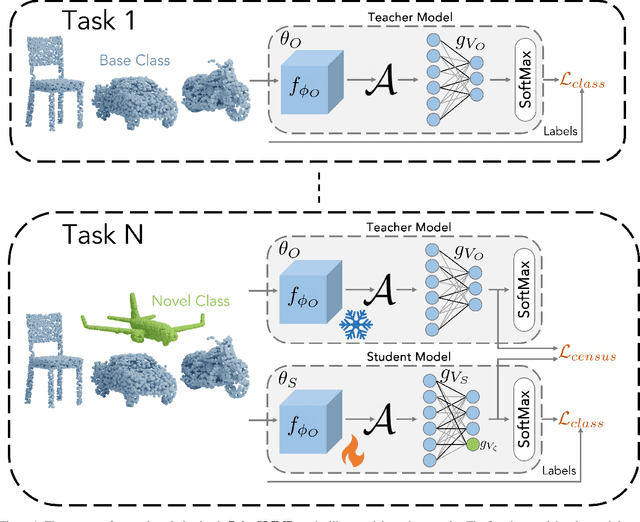
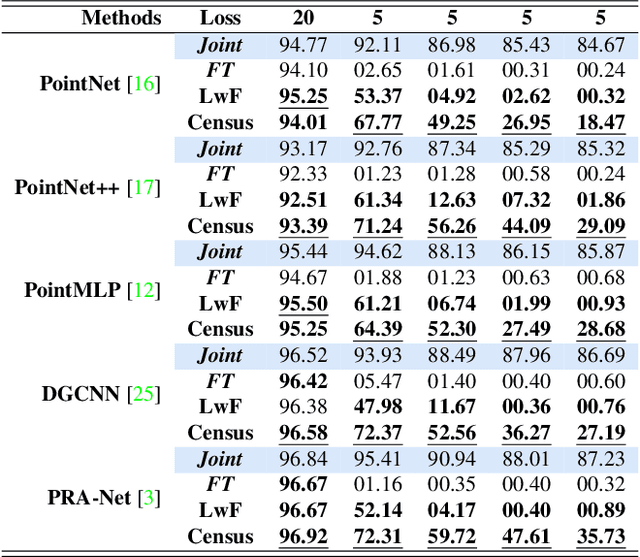


Abstract:Point clouds offer comprehensive and precise data regarding the contour and configuration of objects. Employing such geometric and topological 3D information of objects in class incremental learning can aid endless application in 3D-computer vision. Well known 3D-point cloud class incremental learning methods for addressing catastrophic forgetting generally entail the usage of previously encountered data, which can present difficulties in situations where there are restrictions on memory or when there are concerns about the legality of the data. Towards this we pioneer to leverage exemplar free class incremental learning on Point Clouds. In this paper we propose PointCLIMB: An exemplar Free Class Incremental Learning Benchmark. We focus on a pragmatic perspective to consider novel classes for class incremental learning on 3D point clouds. We setup a benchmark for 3D Exemplar free class incremental learning. We investigate performance of various backbones on 3D-Exemplar Free Class Incremental Learning framework. We demonstrate our results on ModelNet40 dataset.
GPr-Net: Geometric Prototypical Network for Point Cloud Few-Shot Learning
Apr 12, 2023Abstract:In the realm of 3D-computer vision applications, point cloud few-shot learning plays a critical role. However, it poses an arduous challenge due to the sparsity, irregularity, and unordered nature of the data. Current methods rely on complex local geometric extraction techniques such as convolution, graph, and attention mechanisms, along with extensive data-driven pre-training tasks. These approaches contradict the fundamental goal of few-shot learning, which is to facilitate efficient learning. To address this issue, we propose GPr-Net (Geometric Prototypical Network), a lightweight and computationally efficient geometric prototypical network that captures the intrinsic topology of point clouds and achieves superior performance. Our proposed method, IGI++ (Intrinsic Geometry Interpreter++) employs vector-based hand-crafted intrinsic geometry interpreters and Laplace vectors to extract and evaluate point cloud morphology, resulting in improved representations for FSL (Few-Shot Learning). Additionally, Laplace vectors enable the extraction of valuable features from point clouds with fewer points. To tackle the distribution drift challenge in few-shot metric learning, we leverage hyperbolic space and demonstrate that our approach handles intra and inter-class variance better than existing point cloud few-shot learning methods. Experimental results on the ModelNet40 dataset show that GPr-Net outperforms state-of-the-art methods in few-shot learning on point clouds, achieving utmost computational efficiency that is $170\times$ better than all existing works. The code is publicly available at https://github.com/TejasAnvekar/GPr-Net.
1st Workshop on Maritime Computer Vision 2023: Challenge Results
Nov 28, 2022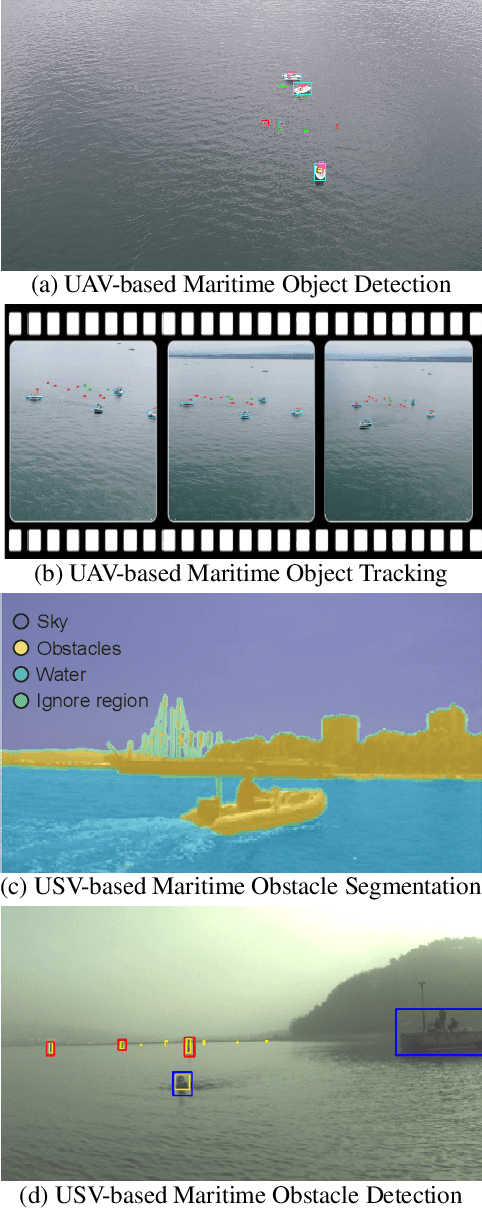
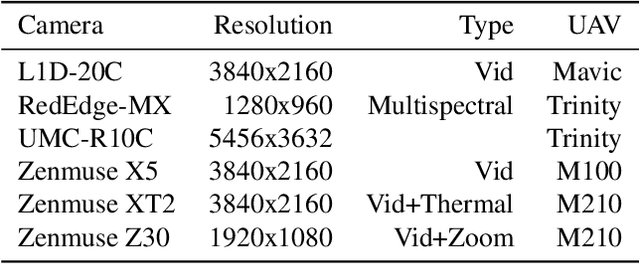
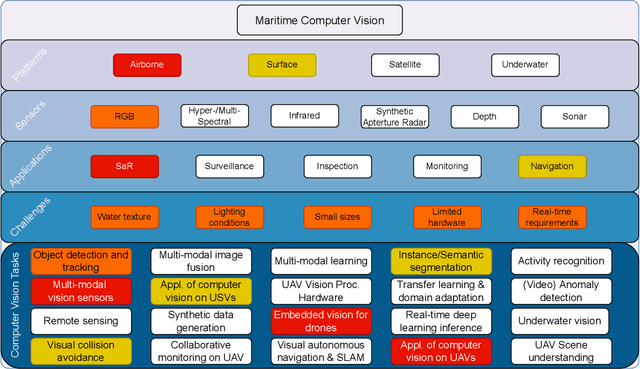
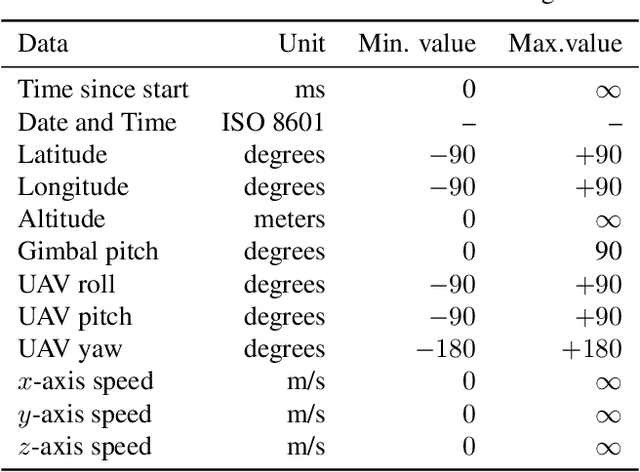
Abstract:The 1$^{\text{st}}$ Workshop on Maritime Computer Vision (MaCVi) 2023 focused on maritime computer vision for Unmanned Aerial Vehicles (UAV) and Unmanned Surface Vehicle (USV), and organized several subchallenges in this domain: (i) UAV-based Maritime Object Detection, (ii) UAV-based Maritime Object Tracking, (iii) USV-based Maritime Obstacle Segmentation and (iv) USV-based Maritime Obstacle Detection. The subchallenges were based on the SeaDronesSee and MODS benchmarks. This report summarizes the main findings of the individual subchallenges and introduces a new benchmark, called SeaDronesSee Object Detection v2, which extends the previous benchmark by including more classes and footage. We provide statistical and qualitative analyses, and assess trends in the best-performing methodologies of over 130 submissions. The methods are summarized in the appendix. The datasets, evaluation code and the leaderboard are publicly available at https://seadronessee.cs.uni-tuebingen.de/macvi.
 Add to Chrome
Add to Chrome Add to Firefox
Add to Firefox Add to Edge
Add to Edge